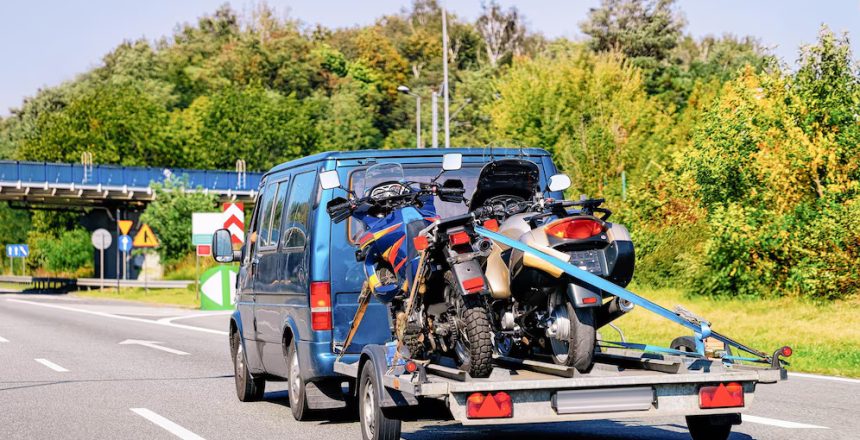When you’re planning to transport your motorcycle, understanding how long it typically takes can help you set realistic expectations. Transport time varies based on distance and the method you choose.
For instance, short trips can be quick, but longer distances may require more patience. Curious about the factors that influence these timelines?
Let’s explore the different transport methods and the timeframes associated with each distance.
Factors Influencing Transport Time
When you’re planning to transport your motorcycle, several factors can impact how long the process will take.
Distance Between Pickup and Delivery Locations
The most significant factor affecting transport time is the distance between where your motorcycle is picked up and where it needs to be delivered.
- Longer distances naturally require more time, as the transport vehicle needs to cover more ground.
- Route planning and the method of transport will also influence the overall journey time.
Seasonal Factors and Weather Conditions
The time of year can greatly influence the duration of motorcycle transport.
- Bad weather, such as snow or heavy rain, can delay travel times, making the journey longer.
- Holiday traffic and peak seasons also lead to congestion, which may affect the timing of delivery.
Motorcycle Type and Special Handling
The type of motorcycle you’re transporting plays a key role in how quickly it can be moved.
- Larger or custom bikes may require special equipment and handling, adding more time to the transport process.
- Extra precautions for securing and loading specific models can also cause slight delays.
Transport Company Efficiency and Paperwork
The transport company you choose has a direct impact on how efficiently your motorcycle is moved.
- A reputable company with a smooth process will help ensure timely transport.
- Necessary permits or paperwork, when not handled ahead of time, can cause further delays, so preparing these in advance is essential.
Different Methods of Motorcycle Transport
Selecting the right method for motorcycle transport can make a big difference in both cost and delivery time. There are several options, each with its pros and cons.
Air Transport: Fast but Expensive
If speed is your top priority, air transport is the fastest option for getting your motorcycle to its destination.
- It’s ideal for urgent deliveries, though the cost is typically higher than other methods.
- Air transport is perfect for high-value or time-sensitive shipments.
Ground Transport: Cost-Effective and Popular
For a more affordable option, ground transport via a specialized motorcycle carrier is a widely used choice.
- Ground transport is popular because it’s reliable and generally more affordable than air transport.
- While it may take longer, it’s still a convenient option for most domestic moves.
DIY Option: Riding It Yourself
If you have the time and the distance isn’t too far, you might consider transporting your motorcycle yourself by riding it to the destination.
- This method saves on transport costs but can be time-consuming and physically demanding.
- It’s perfect for short distances or when you want the experience of riding your bike.
Sea Freight: For International Shipments
When shipping your motorcycle internationally, sea freight is an option, though it requires patience due to longer transit times.
- Sea freight is more affordable than air transport but takes longer to reach its destination.
- This method is best for international shipping when you have more time and a budget-friendly approach.
Typical Time Frames for Various Distances
The distance your motorcycle needs to travel plays a significant role in determining transport time. Depending on the distance and route, the timeline can vary greatly.
Short Distances (Up to 300 Miles)
For local or short-distance transport, you can expect quicker delivery.
- Typically, deliveries within 300 miles are completed in one to two days.
- This is ideal for nearby destinations, making it a quick and easy process.
Medium Distances (300 to 800 Miles)
As the distance increases, so does the transport time.
- For a medium-range trip between 300 and 800 miles, expect delivery within three to five days.
- Factors like weather and road conditions can add slight delays to this timeframe.
Long Distances (Over 800 Miles)
For long-distance deliveries, you need to plan for more extended transport times.
- For trips over 800 miles, transport can take a week or more.
- Longer routes may involve stops, additional logistics, and are more prone to delays due to traffic and weather conditions.
Understanding the factors that influence motorcycle transport time helps you manage expectations and plan accordingly. Whether you choose air transport for speed or ground transport for a cost-effective solution, knowing the distance and method can ensure a smoother process.
Regardless of the method, it’s essential to consider any potential delays and stay flexible with timelines to ensure your motorcycle arrives safely and on time.






